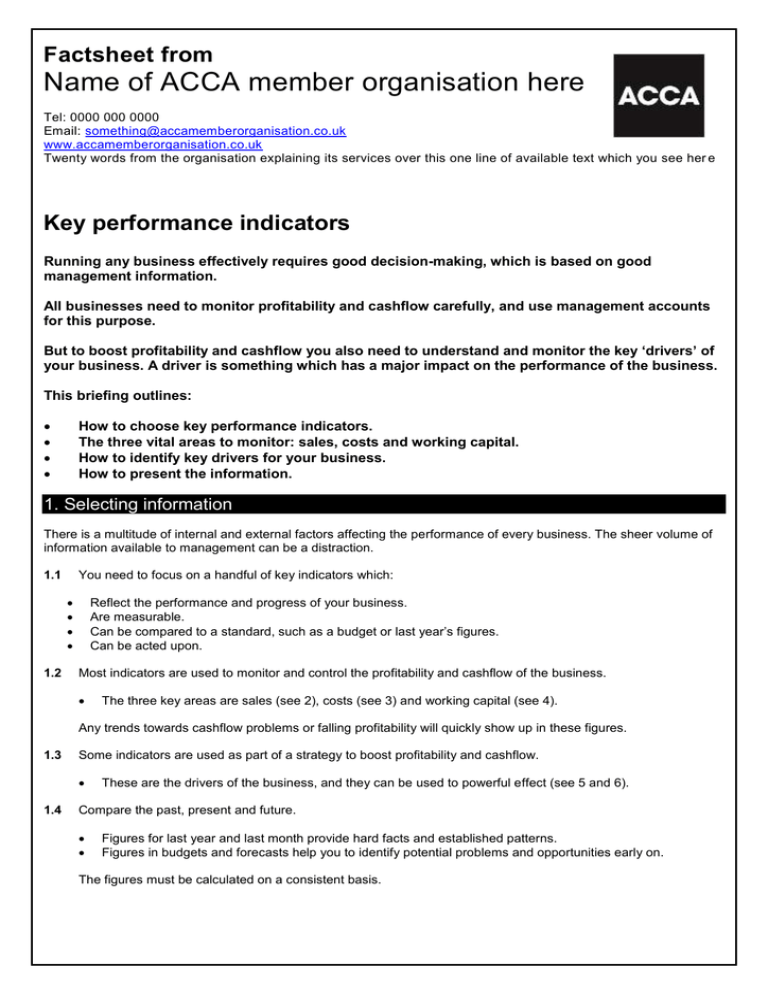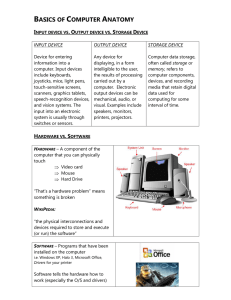
Factsheet from
Name of ACCA member organisation here
Tel: 0000 000 0000
Email: something@accamemberorganisation.co.uk
www.accamemberorganisation.co.uk
Twenty words from the organisation explaining its services over this one line of available text which you see her e
Key performance indicators
Running any business effectively requires good decision-making, which is based on good
management information.
All businesses need to monitor profitability and cashflow carefully, and use management accounts
for this purpose.
But to boost profitability and cashflow you also need to understand and monitor the key ‘drivers’ of
your business. A driver is something which has a major impact on the performance of the business.
This briefing outlines:
How to choose key performance indicators.
The three vital areas to monitor: sales, costs and working capital.
How to identify key drivers for your business.
How to present the information.
1. Selecting information
There is a multitude of internal and external factors affecting the performance of every business. The sheer volume of
information available to management can be a distraction.
1.1
You need to focus on a handful of key indicators which:
1.2
Reflect the performance and progress of your business.
Are measurable.
Can be compared to a standard, such as a budget or last year’s figures.
Can be acted upon.
Most indicators are used to monitor and control the profitability and cashflow of the business.
The three key areas are sales (see 2), costs (see 3) and working capital (see 4).
Any trends towards cashflow problems or falling profitability will quickly show up in these figures.
1.3
Some indicators are used as part of a strategy to boost profitability and cashflow.
1.4
These are the drivers of the business, and they can be used to powerful effect (see 5 and 6).
Compare the past, present and future.
Figures for last year and last month provide hard facts and established patterns.
Figures in budgets and forecasts help you to identify potential problems and opportunities early on.
The figures must be calculated on a consistent basis.
1.5
Compare yourself with other businesses, especially competitors, if possible.
2. Sales
2.1
Enquiry levels (or number of leads, or quotes given) provide early warning of any peaks or troughs in your sales.
2.2
Monitor where the enquiries come from, to establish which marketing campaigns work.
If you have an established enquiry to sales ratio, and know the size of an average sale, you can use the
enquiry level to forecast turnover.
Building up the order book is a key objective of most businesses.
The ‘order book cover’ figure compares the total value of your order book to breakeven sales for one month.
A six-month order book means that you could break even over the next six months without making another sale.
2.3
When reviewing sales, monitor the figures that show what is happening:
Which categories of product are selling well?
How are your priority products (those with the best margins and the best payment terms) selling?
What has each salesperson achieved?
Are your conversion rates (the ratio of leads to sales) changing?
Enquiries, order book and sales progress should be reviewed by the sales team every week. At board level, they
should be reviewed monthly.
3. Costs
Like sales, your costs (and therefore profit margins) should ideally be tracked every week. Many retailers are able to
track them daily.
Identify the key variable costs (eg materials) and what causes them to increase or decrease.
3.1
Maintaining a healthy gross profit margin is critically important.
3.2
Falling margins could result from any number of things eg higher input prices, a changed product mix,
production inefficiencies and discounts.
Group different types of cost into cost centres.
For example, a warehousing and delivery business could split its direct costs into warehousing and delivery.
Matching the costs against the revenue for each half of the business would show how profitable each
operation is.
Related overhead items (eg phone charges, postage and stationery) can be lumped together into one
combined cost figure.
4. Working capital
Cash generation is a major priority for most businesses. You control cash by controlling working capital — debtors,
creditors, stock and work-in-progress.
4.1
Establish how much extra working capital is required to fund each extra 10% increase in monthly sales.
4.2
If sufficient finance is not available, you may need to delay (or reject) large orders.
An effective way to control debtors and creditors is to produce an ‘aged’ list of debtors and creditors, every week.
2
4.3
Any customer payments which are overdue, suspect, or simply large should be highlighted and tracked.
Good stock control allows you to release cash, while still having the correct stock available.
‘Stock turn’ is the ratio of cost-of-sales to stock. If the figure decreases, find out why. For example, you may
be purchasing stock which you cannot sell.
The more you break down the stock figure into separate product categories, the easier it is to see where the
problems are.
Cashflow (and credit control) should be reviewed every week. If this is a problem area, the review should be
daily.
5. The power of drivers
Monitoring your sales, for example, will not necessarily help you improve your sales performance.
By contrast, understanding the drivers behind the sales of your business can provide a breakthrough.
The simplest way to explain drivers is by using examples, such as those below.
5.1
A management consultancy had a disappointing level of monthly sales for years, until it realised that man-hours
sold per consultant per week was the key driver.
5.2
Once this was monitored, it became crystal clear which consultants were earning the revenue. Attitudes
changed overnight and sales increased significantly.
After a period of stability and high profits, a specialist travel agency realised that staff turnover was a driver.
An experienced sales person was found to be three times more productive than a new recruit.
The recruitment and training process for new sales people was a major burden.
To reduce staff turnover, the travel agency introduced a long-term incentive element into remuneration packages.
It also introduced quarterly performance reviews.
5.3
An engineering company found that the defect ratio was a driver.
Defects led to goods being returned, extra work to rectify the faults, delays in payment, and lower prices
being achieved.
The company reorganised the workforce to work in ‘quality cells’ and stopped using a machine which was
unreliable. Productivity increased significantly.
5.4
Drivers vary enormously. For example:
Sales leads in a capital goods business.
Sales per square foot in a retail business.
Market share in a market where only the big will survive.
Machine downtime in a factory.
‘First time fix’ in a maintenance business.
The morale of employees in a nursing home.
Even direct competitors use different drivers to improve their business performance. For example, for some a
prime location is important, for others it’s not a key consideration.
6. Identifying your key drivers
What are the key factors which enable your business to outperform its competitors?
3
The questions you need to ask yourself are: What drives the sales figures? What drives the costs? What drives the
cashflow?
6.1
For most businesses, the key drivers include major cost-efficiency items.
For example, two important drivers for a chicken processing company are inevitably going to be direct labour
costs and yield (the weight of meat taken from each carcass).
Both have a major impact on the gross margin.
6.2
Drivers often include ‘soft’ factors.
6.3
The measurement of drivers is sometimes indirect.
6.4
For example, effective networking (to build new business relationships) has proved to be the key driver for
many newer businesses.
For example, if you have identified employee morale as a driver, you could monitor it by tracking voluntary
overtime, absenteeism and sick days.
The drivers may change with time. The growth of your business, changes in your market or simply seasonal
changes may cause this.
7. Presentation
Management information needs to be presented in a way that makes the important trends easy to see.
You can achieve this by restricting the number of figures you monitor. But the biggest breakthroughs are achieved by
clever use of computer-generated graphs and charts. The trends instantly become clear.
7.1
Specify which figures you wish to review, and when.
Some figures need to be reviewed only once a year, as part of the annual budgeting cycle.
For example, premises costs.
7.2
Include ‘red light’ systems, to alert you to a particular danger or opportunity which could arise.
For some businesses, exception reporting is a useful method.
Specify how you would like the information presented.
A one-page summary sheet is advisable, backed up by detailed supporting information.
The summary sheet could list the key performance indicators, such as total sales and gross margin, plus the top
five drivers that you have identified.
This forces you to concentrate on the issues which have the most impact on your business performance.
The information can be ordered according to functions.
For example sales, production and finance.
7.3
Always present the actual figures alongside the standard figures (eg the budget and prior year), so
comparisons can be made.
Whoever prepares the information should include a written commentary.
This explains any important changes since the previous period, including the reasons behind them.
4
7.4
For example, sales might be low because a particular contract has been delayed.
Special attention needs to be given to any major projects or new areas of business.
Problems usually arise. Identify them early on and take action immediately.
8. Action
If your employees know that you are closely monitoring the performance of the business, people will tend to sort out
most minor problems immediately.
You, the senior management, should therefore have more time and resources to focus on the more important issues.
8.1 Select the most urgent problems, identify the causes, and agree on the best cure for each.
Agree which individual will be responsible for each action item, together with timescales. Record this in the
minutes of the meeting.
If the same problem keeps re-occurring, it is often a sign that the person responsible is not capable of doing
the job properly.
8.2 Avoid being distracted. Always come back to focus on the real drivers of the business.
The signs were there
A sign manufacturer won a large order to make, deliver and install signs for a retail chain with branches throughout
Europe.
Everyone worked frantically to fulfil the order.
The directors did not notice the falling profit margins, which resulted from the optimistic pricing of the delivery and
installation elements of the contract (neither of which they had previous experience of).
Nor, until the crisis stage, did they properly think through the cashflow implications.
They were used to being paid promptly, thirty days after a sign left the factory gate. Now they had to wait until each
sign was delivered, installed and inspected before they could even invoice for it.
Had the company used effective management information systems, they could have anticipated the problems that
arose.
Eye on the ball
Always come back to what drives your business. Take the example of a housebuilder.
The profitability and cashflow of housebuilders is greatly affected by housing prices and sales activity levels in that
market. These in turn are affected by local demand and supply, and interest rates.
But it is all too easy for a housebuilder to ignore these key drivers. There will always be sites which are running over
budget and other distractions.
Suddenly, the housebuilder may find that while he was busy building houses, the market for them has collapsed.
Experts’ quotes
“If, like a management consultancy, your revenue is based on man-hours billed, do not put consultants’ salaries in
overheads. Put them in ‘cost of sales’, to show the true gross profit picture.”
Paddy MccGwire,
Cobalt Corporate Finance
5
“The first step in closely managing a business is to provide yourself with a range of appropriate, accurate and timely
information.”
Steve Richards,
Gill
Expert contributors
Thanks to Paddy MccGwire (Cobalt Corporate Finance).
Last reviewed 01.12.13
© Atom Content Marketing 2013. ISSN 1369-1996. All rights reserved. No part of this publication may be reproduced or transmitted without the
written permission of the publisher. This publication is for general guidance only. The publisher, expert contributors and distributor disclaim all liability
for any errors or omissions. Consult your local business support organisation or your professional adviser for help and advice.
6





